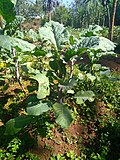Brassica carinata
Brassica carinata, also known as Ethiopian mustard, Abyssinian mustard, or simply as carinata, is a species of Brassica native to the Ethiopian highlands. It is a member of the Brassicaceae family, which includes other important crops such as cabbage, broccoli, and canola.
Description[edit]
Brassica carinata is an annual plant that grows up to 1-2 meters tall. The leaves are broad and lobed, with a waxy surface that helps the plant retain water. The flowers are yellow and arranged in a raceme, and the seeds are small and black, contained within elongated pods.
Cultivation and uses[edit]
Brassica carinata is primarily grown as a source of vegetable oil. The oil is high in erucic acid, which makes it suitable for industrial uses such as biofuel production. In addition, the plant is also used as a cover crop to improve soil health and prevent erosion.
In its native Ethiopia, Brassica carinata is also grown for its edible leaves, which are used in a variety of traditional dishes. The seeds, while not commonly consumed due to their high erucic acid content, can be processed to remove the acid and used as a protein-rich food source.
Research and breeding[edit]
Research into Brassica carinata has focused on improving its oil yield and quality, as well as its resistance to pests and diseases. Breeding programs have also sought to develop varieties that are better adapted to different growing conditions, including drought and high temperatures.
See also[edit]
References[edit]
<references />
This plant related article is a stub. You can help WikiMD by expanding it.
Ad. Transform your life with W8MD's Budget GLP-1 injections from $75


W8MD offers a medical weight loss program to lose weight in Philadelphia. Our physician-supervised medical weight loss provides:
- Weight loss injections in NYC (generic and brand names):
- Zepbound / Mounjaro, Wegovy / Ozempic, Saxenda
- Most insurances accepted or discounted self-pay rates. We will obtain insurance prior authorizations if needed.
- Generic GLP1 weight loss injections from $75 for the starting dose.
- Also offer prescription weight loss medications including Phentermine, Qsymia, Diethylpropion, Contrave etc.
NYC weight loss doctor appointmentsNYC weight loss doctor appointments
Start your NYC weight loss journey today at our NYC medical weight loss and Philadelphia medical weight loss clinics.
- Call 718-946-5500 to lose weight in NYC or for medical weight loss in Philadelphia 215-676-2334.
- Tags:NYC medical weight loss, Philadelphia lose weight Zepbound NYC, Budget GLP1 weight loss injections, Wegovy Philadelphia, Wegovy NYC, Philadelphia medical weight loss, Brookly weight loss and Wegovy NYC
|
WikiMD's Wellness Encyclopedia |
| Let Food Be Thy Medicine Medicine Thy Food - Hippocrates |
Medical Disclaimer: WikiMD is not a substitute for professional medical advice. The information on WikiMD is provided as an information resource only, may be incorrect, outdated or misleading, and is not to be used or relied on for any diagnostic or treatment purposes. Please consult your health care provider before making any healthcare decisions or for guidance about a specific medical condition. WikiMD expressly disclaims responsibility, and shall have no liability, for any damages, loss, injury, or liability whatsoever suffered as a result of your reliance on the information contained in this site. By visiting this site you agree to the foregoing terms and conditions, which may from time to time be changed or supplemented by WikiMD. If you do not agree to the foregoing terms and conditions, you should not enter or use this site. See full disclaimer.
Credits:Most images are courtesy of Wikimedia commons, and templates, categories Wikipedia, licensed under CC BY SA or similar.
Translate this page: - East Asian
中文,
日本,
한국어,
South Asian
हिन्दी,
தமிழ்,
తెలుగు,
Urdu,
ಕನ್ನಡ,
Southeast Asian
Indonesian,
Vietnamese,
Thai,
မြန်မာဘာသာ,
বাংলা
European
español,
Deutsch,
français,
Greek,
português do Brasil,
polski,
română,
русский,
Nederlands,
norsk,
svenska,
suomi,
Italian
Middle Eastern & African
عربى,
Turkish,
Persian,
Hebrew,
Afrikaans,
isiZulu,
Kiswahili,
Other
Bulgarian,
Hungarian,
Czech,
Swedish,
മലയാളം,
मराठी,
ਪੰਜਾਬੀ,
ગુજરાતી,
Portuguese,
Ukrainian
